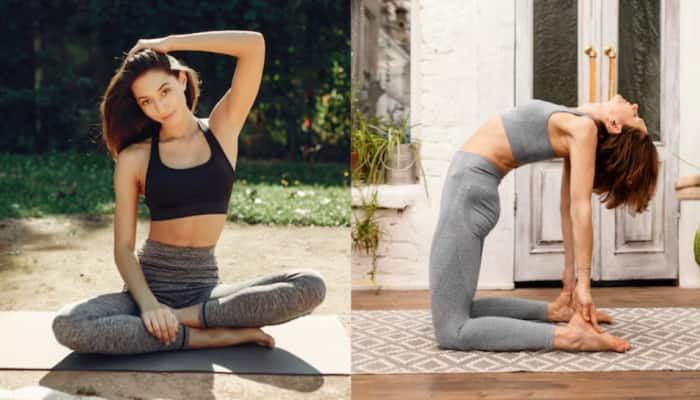Unlock The Secret To Volume And Movement: The Ultimate Guide To Hair Layering
The art of hair layering is a fantastic way to add volume, texture, and movement to your hairstyle, making it look fresh and vibrant. Whether you want to enhance your natural curls, create a sleek, layered bob, or add volume to fine hair, layering is a versatile technique that can suit any hair type or face shape.
Trending Photos
) Image credit: Freepik
Image credit: Freepik Hair layering is an essential technique in modern hairstyling that can transform your hair from flat and lifeless to full of volume, texture, and movement. Whether you have straight, wavy, or curly hair, layering is a versatile and effective way to enhance your natural hair type and give it a fresh, dynamic look. In this guide, we'll explore the art of hair layering, its benefits, and how you can achieve the perfect layered hairstyle for your unique hair texture and face shape.
What Is Hair Layering?
Hair layering involves cutting the hair in varying lengths to create depth and texture. By cutting the hair in layers, stylists can add dimension to the hairstyle, making it appear fuller and more voluminous. Layering works by creating contrast between longer and shorter pieces, allowing the hair to move more freely and naturally.
Unlike a one-length cut, where the hair is cut uniformly, layering adds lightness and shape, which can complement various face shapes and hair types. This technique can be applied to all hair lengths, from short bobs to long, flowing locks, and offers an opportunity to experiment with different looks.
Benefits of Layered Haircuts
1. Volume Boost
For those with fine or thin hair, layering can be a game-changer. The shorter layers on top of longer strands give the illusion of thicker, more voluminous hair. When styled with the right products, the layers can lift the hair, making it appear fuller without the need for bulky, heavy products.
2. Added Texture
Layered cuts create natural movement and texture by breaking up the uniformity of one-length hair. For wavy or curly hair, layers can enhance the natural curl pattern, reducing bulk and frizz while maintaining bounce. For straight hair, layers add a chic, tousled effect that creates an effortless, windswept look.
3. Enhanced Movement
Layering promotes movement within the hair, allowing it to flow more freely. This dynamic quality is particularly noticeable in longer hair, where the layers encourage the hair to move in waves, flips, or curls. The movement adds a lively, energetic element to your hairstyle.
4. Face-Framing Impact
Strategically placed layers can highlight your facial features and provide a flattering frame for your face. For example, face-framing layers around the cheekbones or jawline can soften facial features and bring attention to your eyes, cheekbones, or lips.
5. Low Maintenance
Layered haircuts can be easier to maintain than one-length cuts because layers naturally blend together. Haircuts with layers grow out more gracefully, often requiring less frequent trips to the salon for trims. Additionally, layers work with your hair’s natural texture, so you can spend less time styling and more time enjoying your look.
How to Choose the Right Layered Cut for Your Hair Type and Face Shape
Hair Type Considerations
Straight Hair: Layering on straight hair can add depth and prevent it from looking flat. Opt for long, subtle layers that start around the chin or collarbone for a sleek, sophisticated style. Short layers can add texture, especially around the crown.
Wavy Hair: For wavy hair, layers can help define and enhance your natural waves. A layered cut with shorter layers on top and longer layers at the bottom helps create volume without adding too much bulk. Curved or soft layers work best to complement the flow of natural waves.
Curly Hair: Curly hair benefits greatly from layering as it helps reduce bulk and provides structure to the curls. Layering curly hair enhances the curl pattern and allows it to move more freely. Be cautious not to over-layer, as too many layers can result in the curls becoming unruly.
Fine Hair: Layering is ideal for fine hair because it gives the hair body and volume. To achieve the best results, go for shorter layers that start at the crown and gradually get longer toward the ends. Avoid too many layers, as this can make the hair appear thinner.
Thick Hair: Thick hair benefits from layers that help distribute volume evenly and prevent the hair from looking heavy. Layers can help lightens the weight, reduce bulk, and add movement.
Face Shape Considerations
Oval Face: Oval faces are highly versatile and can pull off almost any style. Layered haircuts that hit at the shoulders or chin enhance the natural symmetry of the face. Soft layers framing the face work well to highlight your cheekbones and jawline.
Round Face: To elongate a round face, opt for longer layers that start below the chin. This can add height and make the face appear slimmer. Avoid too many layers near the cheekbones as this can add width to the face.
Square Face: For a square face, layers that begin below the cheekbones and around the jawline can soften the angularity of the face. Adding volume at the crown and around the temples will also help create balance and a more oval appearance.
Heart-Shaped Face: Heart-shaped faces can benefit from layers that start below the cheekbones and gradually blend into longer layers. This creates balance by drawing attention away from the forehead and toward the chin.
Layering Techniques
Long Layers: These layers maintain length while adding movement and body. Ideal for medium to long hair, long layers create soft transitions and prevent hair from looking weighed down.
Textured Layers: A more dynamic approach, textured layers are ideal for creating choppy or messy looks. These layers are usually cut at varying angles to provide an edgier, more modern style.
Face-Framing Layers: These layers are cut to accentuate your face, especially the cheekbones or jawline. They're typically shorter layers that blend into the rest of the hair, creating a flattering frame for your features.
Layered Bob: The layered bob is a timeless, versatile style that works for almost any hair type. Layers add volume to the bob while maintaining its sleekness, allowing for movement and texture.
Tips for Styling Layered Hair
Use a Volumizing Mousse: To boost the volume in your layered hair, apply a volumizing mousse to damp hair before blow-drying. This helps lift the roots and create fullness.
Avoid Heavy Products: Since layering naturally adds texture, avoid heavy styling products that can weigh down the layers. Instead, opt for light texturizing sprays or sea salt sprays to enhance the movement and texture.
Embrace Natural Waves: Let your natural hair texture shine through. Layered cuts often look best when styled with minimal effort, so avoid over-straightening or over-curling.
Use a Round Brush: When blow-drying, use a round brush to add volume and curl the ends slightly for a polished finish that emphasizes the layers.
Regular Trims: To maintain the shape and integrity of your layered haircut, make sure to get regular trims every 6-8 weeks. This helps prevent the layers from growing out unevenly.
By understanding the fundamentals of layering and consulting with a skilled stylist, you can achieve a look that is both flattering and low-maintenance. Embrace the beauty of layers and enjoy a hairstyle that radiates energy, dimension, and effortless style!
(This article is intended for your general information only. Zee News does not vouch for its accuracy or reliability.)
Stay informed on all the latest news, real-time breaking news updates, and follow all the important headlines in india news and world News on Zee News.
Live Tv







)
)
)
)
)
)
)
)
)
)
